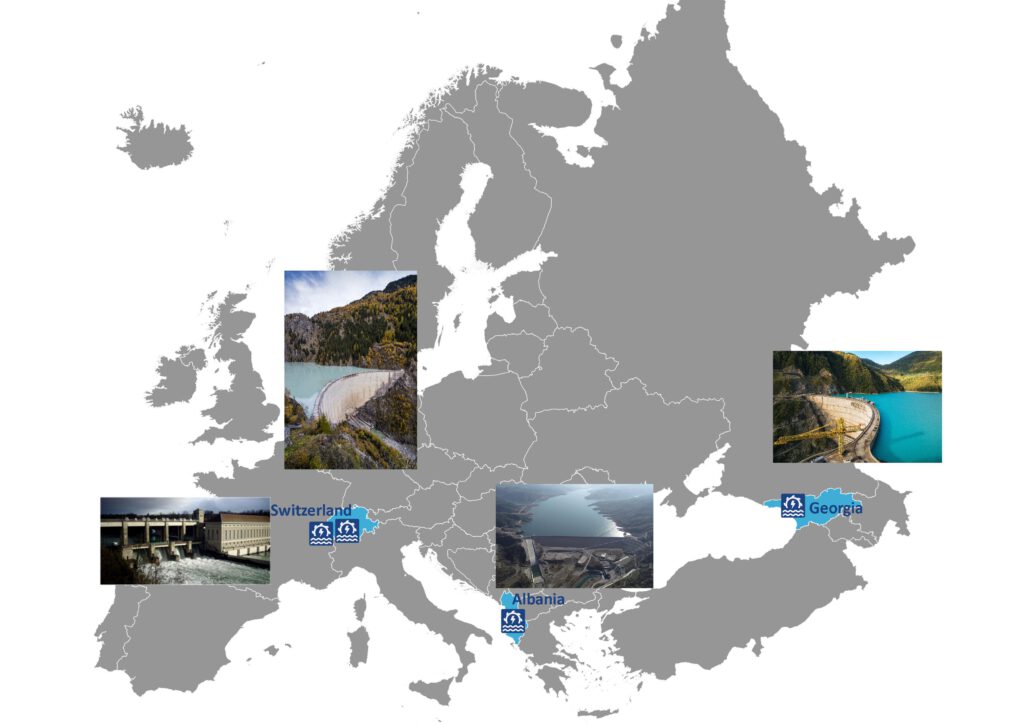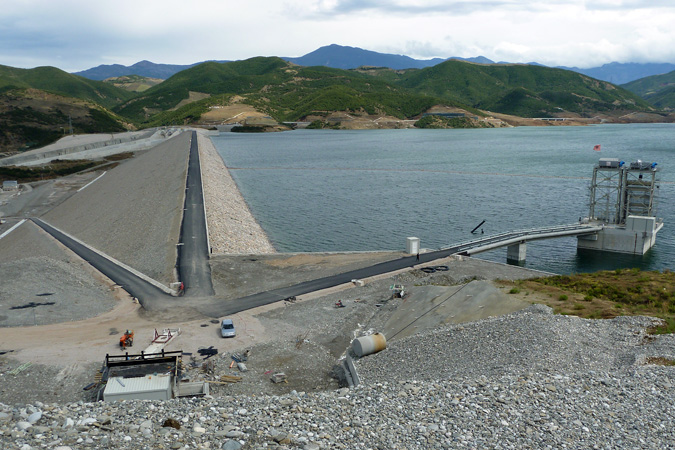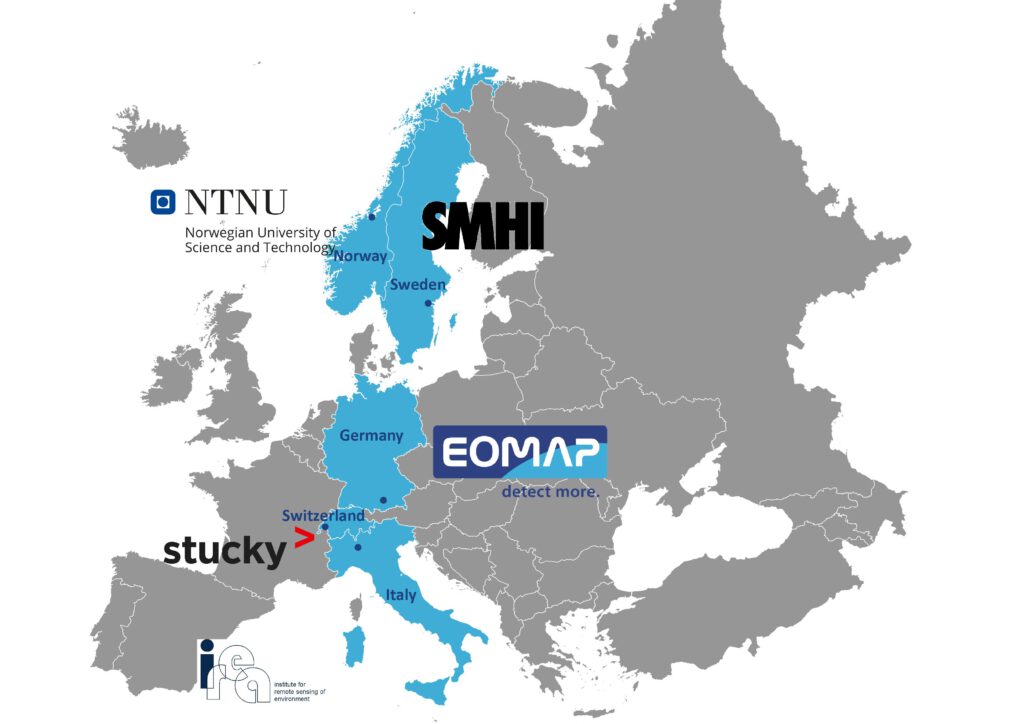HYPOS at a glance
A novel space enabled Hydro-Power-Suite
The HYdro-POwer-Suite (HYPOS) leads the next generation of water resources and sediment management tools. It transforms satellite-based water quality and sediment related parameters into business relevant tools for the hydropower industry, enabling effective environmental and economic investment planning. This online tool for the hydropower industry combines Earth Observation (EO) technologies with hydrologic modelling, and can be complemented by local on-site information.
The HYPOS solution is right for you if you would like an easy access to data and assessments that are essential for planning and monitoring. HYPOS can offer for example inflow/outflow volumes, sediment management (e.g. flushing or dredging) evaluation, near real-time monitoring of sediment management activities (e.g. downstream sediment concentrations), evaporation rates, bank and bed erosion, phytoplankton and higher aquatic vegetation development, all presented in ready-to-use formats to provide support for environmental evaluation, reporting and impact assessments.
Dating back to the early 1980s various spatial and temporal resolutions can be obtained from EO. For water bodies at least 30 m wide, these values can be derived at 10-30 m grids every 3 to 5 days. Daily coverage is possible for larger water bodies with coarser resolution or by using commercial satellite data, that also provides higher resolutions up to 2m and can be tasked for specific events. Hydrological models can provide data at daily resolution for historical period up to today and even forecasting future conditions if desired.
The combination of state-of-the art satellite and hydrological data provided by the HYPOS in a ready-to-use format enables us to support our customers with the most advanced cutting-edge technology in planning and managing both small and large hydropower projects.
Have a look at: https://hypos-project.eu/
“In Brazil, a country with over 500 hydropower plants, the HYPOS suite with its state-of-the art satellite and hydrological data would be a powerful tool in the broad market. In Lactec’s experience, we see that sedimentation in reservoirs problematic is a recurrent theme, one that would greatly benefit from the suite.”
HYPOS real world applications
The suite works in any location in the world, the next one could be yours!
Currently HYPOS adresses 4 real-world use cases:
- Gebidem Dam (Switzerland)
- Verbois/Chancy Pougny hydropower plant (Switzerland)
- Enguri hydroelectric power plants (Georgia)
- Banja hydropower plant (Albania)

A closer look to: The Banja hydropower plant
Banja hydropower plant is located in the Cërrik Municipality in Elbasan County, 65 kilometres southeast of Albania’s capital Tirana. The total production is be 255 GWh/y. The power plant was officially opened in September 2016 as the first plant to be completed by Devoll Hydropower Sh.A. (DHP), an Albanian-registered company, owned and operated by Statkraft. In line with a concession agreement approved by the Albanian parliament in 2009, Devoll Hydropower will build, own and operate hydropower plants in a cascade along the Devoll River in southeast Albania.

The construction of Banja at the Devoll River started in June 2013. More than 2000 workers contributed to its construction activities. The plant has three Francis turbines with an installed capacity of 72 MW. A dam height of 80 metres creates a reservoir with a total volume of ca 400 billion litres of water that covers an area of ca 14 square kilometres.
Banja is only one part of the Devoll project in Albania. Together with a power plant Moglicë that started operating in 2019, joint total output for the project will reach 269 MW. Moglicë’s reservoir with an area of ca 7 square kilometres holds a total volume of ca 380 billion litres behind a 167 m high dam. The two plants will have an annual production of 705 GWh, which represents a 17-percent increase in Albania’s total energy production.
At the end of 2015 a research station was installed to monitor the suspended sediment concentrations (SSC) in river Devoll every 30 min. The station records SSC continuously at the Kokel bridge at all times when the water depth exceeds one meter since January 2016. This research station complements a gauging station at the same location that has been operated by Statkraft since 2008. HYPOS will leverage the SSC data from Kokel together with the SSC and turbidity data taken in the Banja reservoir in order to ensure good data quality for the satellite-derived information.
HYPOS feedback
Understanding the sectors challenges is the key for targeted solutions
HYPOS suite is designed to address key challenges of the hydropower sector together with selected actors. However, further continuous improvements through additional user interactions will allow refinement and development of targeted solutions for all hydropower sector outside the current case studies. Thus, if you are working in the sector and would like to contribute, please fill out our dedicated online questionnaire – it should take 10 minutes at most. If you choose so, you will also have an opportunity to become a part of the HYPOS community and receive the latest information about the suite. Upon submission of the questionnaire you will also receive a free sample of a high resolution satellite-based turbidity map for your area of interest (depending of reservoir size and data availability).
Latest HYPOS publications
The science behind the solution
HYPOS partners are actively sharing the science behind the suite as well as their experiences from the development and first applications of their tools. You can check out our new publications and presentations below.
- Alena Bartosova, Berit Arheimer, Alban de Lavenne, René Capell, Johan Strömqvist, 2021: Large-scale hydrological and sediment modeling in nested domains under current and changing climate. Journal of Hydrologic Engineering. DOI: 10.1061/(ASCE)HE.1943-5584.0002078, Link
Abstract: Continental and global dynamic hydrological models have emerged recently as tools for large-scale analyses. One such tool is a dynamic process-based rainfall-runoff and water quality model Hydrological Predictions for Environment (HYPE). We present and compare historical simulations of runoff and sediment concentrations for three nested model domains using global, continental (Europe), and national (Sweden) catchment-based HYPE applications. Future impacts on runoff, soil moisture, and aridity from changing climate were assessed using the global and continental HYPE applications with 3 CMIP5 GCMs. Simulated sediment concentrations varied considerably among the nested models in spatial patterns due to different data sources while runoff values were more similar. Regardless of the variation, the global model was able to provide information on climate change impacts comparable to those from the continental and national models for hydrological indicators. Global hydrological models are thus valuable tools for e.g. first screenings of climate change effects and detection of spatial patterns. Comparison across nested domains demonstrates the significance of scale which needs to be considered when interpreting the impacts alongside with model performance. - EGU21-10919– Sustainability as a challenge to face and a goal to reach: interdisciplinary approach to support raw materials and energy supply
Abstract: In this study we present the first products from the HYPOS project. These products are representative of what can be generated within the Decision Support Tool (DST) using elaboration techniques of EO data. Gridded products of water quality parameters (e.g. water turbidity, Chlorophyll-a concentration, suspended sediments concentration) are generated for the test sites of the project, which are small dammed reservoirs located in Switzerland, France, Albania and Georgia. These products are obtained using the Modular Inversion and Processing System (MIP), a sensor independent image processing chain based on radiative transfer models, which works in a multi-layer system, solving the light transfer in the atmosphere, at the water surface and inside the waterbody. For the assessment of the “blue footprint” of a reservoir, the water loss due to evaporation is computed by applying a consolidated mass transfer evaporation method to EO data. The resulting evaporation rates are first compared with the outputs of semi-automatic evapotranspiration EObased models (e.g. SEBAL), and then with the estimates obtained from two different numerical models: a hydrological model (E-Hype) and a 3D hydrodynamic model (Delft3D). The key parameters influencing water evaporation rates, their behaviour and the issues related to each approach are analysed. The first comparison results are made for lake Garda, where a complete set of data is available for the production of evaporation maps. - Other contributions partially supported by HYPOS that were accepted for EGU 2021:
- EGU21-15426 Evaluation of surface runoff model hypothesis by multi-objective calibration using discharge and sediment data by Alban de Lavenne et al. Session HS2.3.7 – Multi-dataset, multi-variable, and multi-objective techniques to improve prediction of hydrological and water quality models and their Bayesian applications
- EGU21-14251 Modelling losses of reservoir storage capacity from sedimentation in different landscapes; by Conrad Brendel et al. Session HS2.2.1 – Understanding hydrological processes across spatio-temporal scales: from data to model
- EGU21-8852 Are large scale models useful? A case of nested model domains for assessing current and future stream runoff and sediments by Alena Bartosova et al. Session HS2.5.1 – Large scale hydrology
HYPOS events
Meet the team at upcoming events
The HYPOS project will be presented at several events, amongst others at:
- 19–30 April 2021 at EGU (online)
- 13-15 July 2021 at HYDRO Africa, Lake Victoria, Uganda
- HYPOS workshop in summer 2021 – details will be provided in the next newsletter in May 2021
The HYPOS team is happy to hear from you – contact us at: contact@hypos-project.eu
